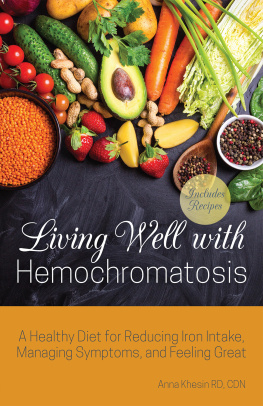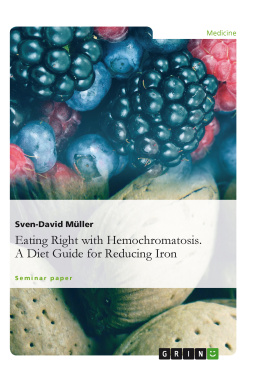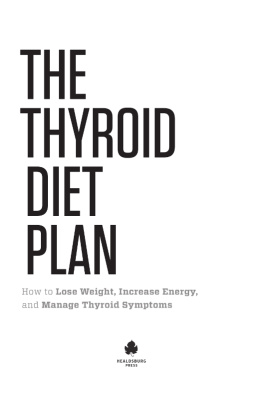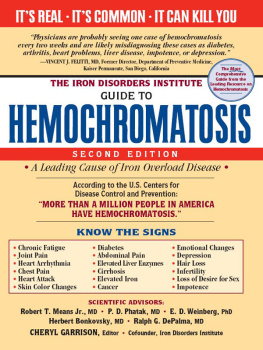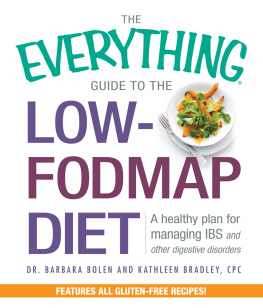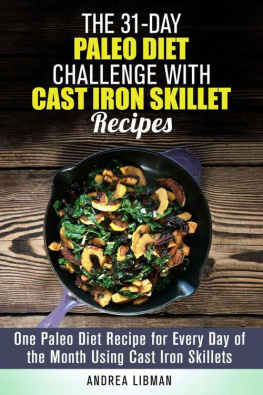
Living Well with
Hemochromatosis
A Healthy Diet for Reducing Iron Intake, Managing Symptoms, and Feeling Great
Anna Khesin, RD, CDN
Text copyright 2019 Anna Khesin. Design and concept copyright 2019 Ulysses Press and its licensors. All rights reserved. Any unauthorized duplication in whole or in part or dissemination of this edition by any means (including but not limited to photocopying, electronic devices, digital versions, and the internet) will be prosecuted to the fullest extent of the law.
Published in the United States by:
Ulysses Press
P.O. Box 3440
Berkeley, CA 94703
www.ulyssespress.com
ISBN: 978-1-61243-916-7
Acquisitions editor: Casie Vogel
Managing editor: Claire Chun
Project editor: Renee Rutledge
Proofreader: Susan Lang
Front cover and interior design: what!design @ whatweb.com
Cover photo: Elena Eryomenko/shutterstock.com
Production: Jake Flaherty
IMPORTANT NOTE TO READERS: This book has been written and published for informational and educational purposes only. It is not intended to serve as medical advice or to be any form of medical treatment. You should always consult with your physician before altering or changing any aspect of your medical treatment. Do not stop or change any prescription medications without the guidance and advice of your physician. Any use of the information in this book is made on the readers good judgment and is the readers sole responsibility. This book is not intended to diagnose or treat any medical condition and is not a substitute for a physician. This book is independently authored and published and no sponsorship or endorsement of this book by, and no affiliation with, any trademarked brands or other products mentioned within is claimed or suggested. All trademarks that appear in ingredient lists and elsewhere in this book belong to their respective owners and are used here for informational purposes only. The author and publisher encourage readers to patronize the quality brands mentioned in this book.
Contents
Introduction
Chances are, you have many questions about hemochromatosis. For the following real people, the quest for answers began with unexplained symptoms.
Lucy, at 46 years old, was experiencing weakness, lethargy, joint pain, and difficulty walking. She had stopped menstruating approximately two years prior and developed hot flashes around that time.1
Danny, a gay man, feared that he may have been exposed to HIV after he developed a persistent, itchy rash.2
Rick persistently consulted with a variety of doctors to attempt to determine the cause for his fatigue, gray skin hue, hair loss, and severe pain in the abdomen as well as in a couple of fingers and knuckles.3
Darryl, despite leading a healthy lifestyle, encountered advancing symptoms over the span of two decades, beginning at age 34. His initial reason for concern was his elevated triglycerides along with an intensifying pain in the knees, hips, and big toe. Eventually, the joint pain only worsened, and feelings of exhaustion were perpetual. In his forties, Darryl began to experience irregular heartbeat, weight gain, bloating, abdominal pain, and depression. By his fifties, he was diagnosed with sleep apnea and was found to have uncontrollable blood sugar.4
What could all of these symptoms mean? No one story is identical to the other. Those who experience them could be male, female, homosexual, heterosexual. Dannys itchy skin could be the outcome of an iron deficiency. Rick could just be a hypochondriac, always anxious over the slightest discomfort, running back to the doctor with a new discovery alongside the same old complaints. And Darryl could simply be experiencing the typical signs of aging. Its not uncommon to have less energy or to put on a little weight over the years. For his high triglycerides, he began to be treated with medication once diet intervention and exercise proved to be unsuccessful. The joint pain was considered to be gout, wear and tear from years of running, and the beginnings of arthritis. These are all seemingly unrelated symptoms. Could there possibly be a common thread?
The simple answer is yes. A condition by the name of hemochromatosis, if undetected, can compromise vital organs in the body, which can result in widespread symptoms and diseases. The silver lining in all of this is, if you have decided to read this book, then you likely either already know that you have the disorder or know someone who does and can now go on a path toward health and longevity.
This book is intended to offer insight into what hemochromatosis is and how the foods that you eat can contribute to the burden or can help manage it better with the help of a collection of simple and delicious recipes. Most importantly, this book was written to impart useful tips so that you are empowered to confidently venture out and enjoy meals other than the ones provided in this guide.
1. L. Rojas-Roldan and T. Wilkins, Case Report, The Journal of Family Practice 66, no. 6 (2014): 305308.
2. P. Whitaker, Health Matters, New Statesman (2015): 63.
3. Canadian Hemochromatosis Society. Iron Chronicles: Rick. Accessed June 30, 2018, https://www.toomuchiron.ca/iron-chronicles/rick/.
4. Canadian Hemochromatosis Society. Iron Chronicles: Darryl. Accessed June 30, 2018, https://www.toomuchiron.ca/iron-chronicles/darryl/.
CHAPTER 1
What Is Hemochromatosis?
Hemochromatosis is a hereditary condition that causes the body to absorb and store too much iron. (For the purposes of this book, I will use the terms hemochromatosis and hereditary hemochromatosis interchangeably.) Being that it is inherited and therefore rooted in ones genes, it is not a disorder that is contagious or can one day randomly appear. All people have an HFE gene (think H stands for hereditary, and Fe is the symbol for iron on the periodic table), which plays a key role in tightly regulating iron metabolism in the body. If this gene is mutated, hereditary hemochromatosis may develop. A variety of mutations are possible, some more closely associated with the development of hemochromatosis than others. Researchers are continuously discovering variant mutations of the HFE gene, allowing us to have greater insight into the disease.
The three most common mutations that precipitate hemochromatosis are C282Y, H63D, and S65C. The C282Y type is the one most commonly found in people whose bodies are unable to regulate iron absorption.
In order to have hemochromatosis, a person needs to receive two copies of the defective geneone from their father and one from their mother. However, having both copies does not automatically mean that iron overload will develop. It simply indicates that there is increased risk. The chances are greater in individuals who have two copies of the C282Y mutation than those with one C282Y mutation and one copy of the H63D or S65C mutation.
Those who have only one copy of the mutated gene are considered to be carriers. They can pass along this mutation to their children and likely will not experience hemochromatosis themselves unless they also have another mutation that enhances iron absorption. Whether or not their child will inherit hemochromatosis depends on the makeup of the other parents HFE gene. Since the presence of hemochromatosis is dependent on a persons family tree, anyone diagnosed should proactively share their story with blood relatives and encourage them to get tested.
Next page
